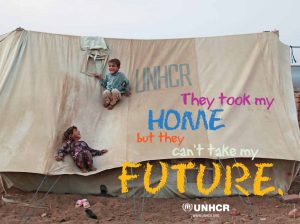 Imagine making the decision to leave your home because a civil war has erupted in your country and it isn’t safe to stay. You are forced from your home and have to search for shelter in a different part of the world. You are met with financial, geographic and language barriers. You might get relocated to another country to start a new life in a safe, hopefully welcoming environment. You might stay in a nearby country in hopes of returning to your home one day. Or you might live in a refugee camp for a time. This is the new normal for millions of displaced people around the world.
Imagine making the decision to leave your home because a civil war has erupted in your country and it isn’t safe to stay. You are forced from your home and have to search for shelter in a different part of the world. You are met with financial, geographic and language barriers. You might get relocated to another country to start a new life in a safe, hopefully welcoming environment. You might stay in a nearby country in hopes of returning to your home one day. Or you might live in a refugee camp for a time. This is the new normal for millions of displaced people around the world.
Today, June 20, is World Refugee Day. The day has been observedinternationally since 2001 and is dedicated to raising awareness of the plight of refugees worldwide. People become refugees for a number of reasons: war, climate change, famine or other factors. People have been forced to flee their homes at a staggering rate, and in numbers not seen since the Second World War. According to 2016 data from the U.N. Refugee Agency (UNHCR), there are 65.3 million forcibly displaced people worldwide. There are more than 21 million refugees, per UNHCR, including about 5 million Palestinian refugees. More than half of refugees worldwide came from three countries — Somalia, Afghanistan, and Syria.
Award-winning photojournalist Lynsey Addario has spent years documenting refugees around the world. In a 2016 documentary, Addario made a point when she was following the experiences of Rohingya Muslims in Myanmar – a point many more priviledged people seem to forget. “People need to understand the plight of refugees. The fact that no one wants to leave their home and no one wants to be a refugee. This is something that is forced upon them,” Addario explained.
Last year, 0.66% of the world’s refugees were approved for resettlement in another country. Less than one percent. According to UNICEF estimates, 28 million children have been uprooted by war and millions more by poverty. Millions of girls and boys are being caught in the crossfire of conflict beyond their control. Refugee children don’t choose where they’re born or who their parents are, and they deserve the same opportunities and right to a safe and happy childhood as any other child. On World Refugee Day, the global community should rededicate itself to working harder to support refugees and address the underlying issues that cause millions of people to flee their homes each year. Unlike with past conflicts and crises, anyone with Internet access can watch the refugee crisis play out in real time, in all parts of the globe. “Never again” should mean never again, and this year the global community needs to redouble their efforts to stem the refugee crisis.
Here are some ways you can make a difference on World Refugee Day:
- Donate to one of the many organizations that help refugees around the world. Organizations like UNHCR, Doctors Without Borders, UNICEF and Save the Children are all great places to start. See this list for more information.
- Watch the mini-documentary, REFUGEE, on Netflix. This powerful 23-minute film follows five photojournalists documenting refugee life around the world.
- Download the UNHCR app and explore their interactive message about the current refugee crisis. Pick a character who has been displaced or separated from their family and make decisions in order to get to safety.
- Sign the #WithRefugees petition and raise awareness about the current refugee crisis via social media.
If you haven’t already, I urge all of our Girl Museum followers to educate yourselves further about the plight of refugees. And maybe, just maybe, we can make a positive difference in the lives of millions of displaced people around the world.
-Sage Daugherty
Junior Girl
Girl Museum Inc.

Thanks for letting me know about a very important crisis in our world and ways I can assist…